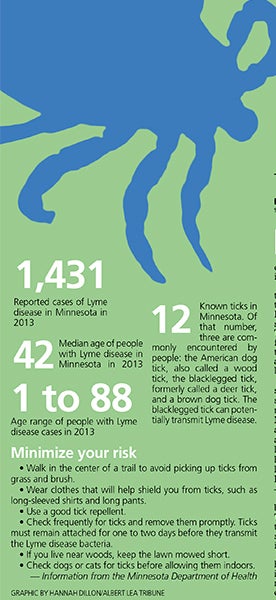Fighting infestation: Ticks worse than usual this year
Published 9:00 am Sunday, July 12, 2015
Minnesota has seen more ticks this summer than previous years, but the risk for any tick-borne disease has generally been low in the Freeborn County area.
Dave Neitzel, supervisor of the vector disease program at the Minnesota Department of Health, said there are about 12 species of ticks in Minnesota. The two that get onto people frequently are the blacklegged tick, also known as a deer tick, and the wood tick, which is also known as an American dog tick.
Neitzel said he has done field sampling this year across the state, and in southeastern Minnesota, particularly near the Mississippi River, he has seen a substantial amount of dog ticks and a low population of blacklegged ticks. He typically sees higher populations of the blacklegged ticks — which can carry Lyme disease and other diseases — north of the Twin Cities.
He said there are more of the blacklegged ticks north of the Twin Cities primarily because of the geography of that part of the state. They are typically found in woods and brush.
While Freeborn County does have some woods, a majority of it is more agricultural, leading to more of the dog ticks. Dog ticks can be in a variety of habitats, including grassy fields and woody areas.
Tom Wanous, assistant park manager at Myre-Big Island State Park, said earlier this year the state park had more wood ticks than normal, but as far as he knows there were no instances of blacklegged ticks.
Neitzel said regular wood ticks typically have a white marking on their bodies, while the blacklegged tend to be blackish-brown, and females have an orange color on their back-end.
He said the adult stage for ticks comes as soon as the snow melts in the spring. Then, they fade out in mid-July. In mid-September through early November, the next generation of adults comes out. Most of the disease risk comes when the blacklegged tick is in its nymph stage, and they could be as small as a black dot that is only between a millimeter and a millimeter and a half long.
All disease transmission occurs from adult females or ticks in the nymph stage.
Some of the symptoms of Lyme disease include an expanding rash after being out in woods or brushy areas in the past month. Sometimes there is a bullseye rash and other times there is just a big, red rash. Within a month of the tick bite, people may feel a headache, fever, muscle aches and fatigue.
Neitzel said Lyme disease does not typically kill the people affected by it, but can have long-term effects — such as chronic arthritis.
The second most common tick-borne disease is human anaplasmosis. It is transmitted by the blacklegged tick. Neitzel said this disease is common in Minnesota and Wisconsin.
People with this disease will have a rapid onset of a high fever, shaking and chills, to name a few symptoms.
As risk for ticks winds down until fall, Neitzel said Minnesotans should now gear up for problems with mosquitos from late July through September.
He said the type of mosquito that can transmit the West Nile virus is becoming more abundant, though there have been no reported cases of this yet. He said the risk for West Nile is later in the summer after it has had a chance to circulate more.
Greater risk comes with warmer weather.
Neitzel noted that 75 percent of people with West Nile are able to fight it off without any symptoms or such mild symptoms that they don’t even seek health care. One out of every 150 cases is more life-threatening.
Another mosquito-borne disease that is in this area is the La Crosse encephalitis, which was discovered in the 1960s. This disease affects mainly children and is transmitted through mosquitos often seen around water-holding containers.
He encouraged people to prevent this type of mosquito in their yards by getting rid of water-holding containers.
More information can be found through the Minnesota Department of Health website at www.health.state.mn.us.






